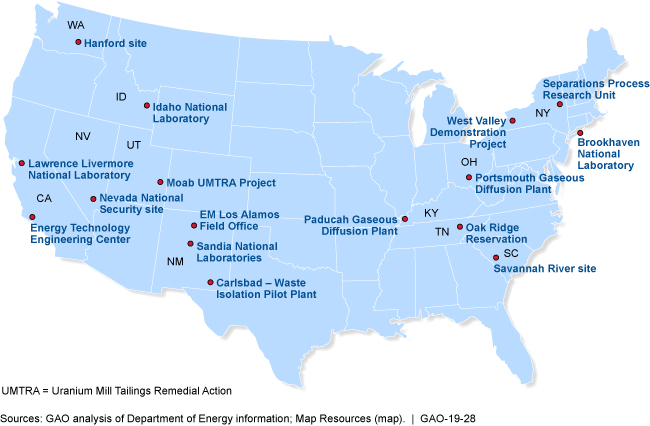
At some point, DOE will have to admit that it has no idea what it will cost to cleanup the Cold War nuclear weapons complex sites. DOE should stop making more wastes until the existing wastes are remediated. The new estimate is more that twice the amount that has been spent in total since cleanup began in 1989, with the most difficult sites still to come.
We’ve said it before and we’ll say it again – Clean Up, Don’t Build Up!
The thing is that the new $377 billion estimate includes leaving much of the waste behind.
Program-Wide Strategy and Better Reporting Needed to Address Growing Environmental Cleanup Liability GAO-19-28: Published: Jan 29, 2019. Publicly Released: Jan 29, 2019.
The Department of Energy is tasked with cleaning up waste from Cold War nuclear weapons production, much of which is hazardous or radioactive. The department’s Office of Environmental Management estimates that future work could cost at least $377 billion—$109 billion more than last year’s estimate.
Some outtakes from the GAO Report –
Each of the 16 cleanup sites sets its own priorities, which makes it hard to ensure that the greatest health and environmental risks are addressed first.
From fiscal years 2011 through 2018, EM’s environmental liability grew by about $214 billion—outpacing its cleanup spending of about $45 billion for that time period.
The department’s Office of Environmental Management (EM) manages most of DOE’s cleanup activities for legacy defense waste and energy research. EM has spent more than $170 billion since it began its cleanup program in 1989, but its most challenging and costly cleanup work remains, according to DOE documents.
EM’s cleanup responsibilities generally include (1) storing and treating about 90 million gallons of radioactive and hazardous waste located in nearly 240 large underground tanks at three sites across the country; (2) remediating millions of cubic meters of soil and more than 1 billion gallons of groundwater; (3) preparing and disposing of 2,400 metric tons of spent nuclear fuel and about 21 metric tons of surplus highly enriched uranium materials; and (4) deactivating and decommissioning about 1,700 excess facilities, some of which are highly contaminated.
In fiscal years 2016, 2017, and 2018, EM anticipated that it needed nearly $8 billion annually to meet schedule milestones called for in compliance agreements. These agreements are legally enforceable documents defining cleanup activities that DOE must achieve by specified dates. DOE’s budget requests for those fiscal years were $5.8 billion, $6.1 billion, and $6.5 billion, respectively.69 In the December 2015 presentation, EM’s Deputy Assistant Secretary stated that in the coming 2 decades, if EM continued to receive about $6 billion per year, it would face a funding shortfall of about $28 billion. Without obtaining the additional funding, according to the 2015 presentation, the time frame for EM’s cleanup mission would likely be extended for years, thereby increasing cleanup costs and raising the environmental liability, according to DOE audit documentation.
GAO is making three recommendations to DOE.
The Secretary of Energy should direct DOE’s Office of Environmental Management to develop a program-wide strategy that outlines how DOE will direct available resources to address human health and environmental risks across and within sites. (Recommendation 1)
The Secretary of Energy should direct DOE’s Office of Environmental Management to submit in EM’s annually required Future-Years Defense Environmental Management Plan all mandated requirements, as well as information on annual growth in environmental liability estimates by site, the key factors causing that growth, and an explanation of significant differences between environmental liability estimates and life cycle cost estimates. (Recommendation 2)
The Secretary of Energy should direct DOE’s Office of Environmental Management to disclose the funding EM needs to meet all of its schedule milestones called for in compliance agreements in, for example, supplemental reports or the annual Future-Years Defense Environmental Management Plan. (Recommendation 3)
